The Samsung Galaxy S7 & S7 Edge Review, Part 1
by Joshua Ho on March 8, 2016 9:00 AM ESTSoC Performance
While we’re ready to move on to newer benchmarks for 2016, our system performance benchmarks from 2015 are still going to provide a pretty good idea for what to expect from the Galaxy S7 and Snapdragon 820 by extension. For those that are unfamiliar with what the Snapdragon 820 is, I’d reference our previous articles on the Snapdragon 820.
In essence, we’re looking at a 2x2 CPU configuration with 2.15 GHz Kryo cores for the performance cluster, and 1.6 GHz Kryo cores for the efficiency cluster. Binding the two clusters together are some power aware scheduling at the kernel level and a custom interconnect to handle coherency between the two clusters. Memory is also improved relative to the Snapdragon 810, with a bump to LPDDR4-1866 over the former's LPDDR4-1600. Of course, there's a lot more to talk about here, but for now we can simply look at how the Snapdragon 820 compares in our benchmarks.
Update: As we've had a few questions on the subject, I just want to clarify browser testing. Samsung's stock browser was not included with our Verizon-branded sample phone, nor is it possible to install it at this time. As a result we are unable to test the performance of Samsung's browser. The Verge reports that this is a Verizon decision and that all Verizon phones will be shipping like this; so for these phones Chrome is the de-facto stock browser.
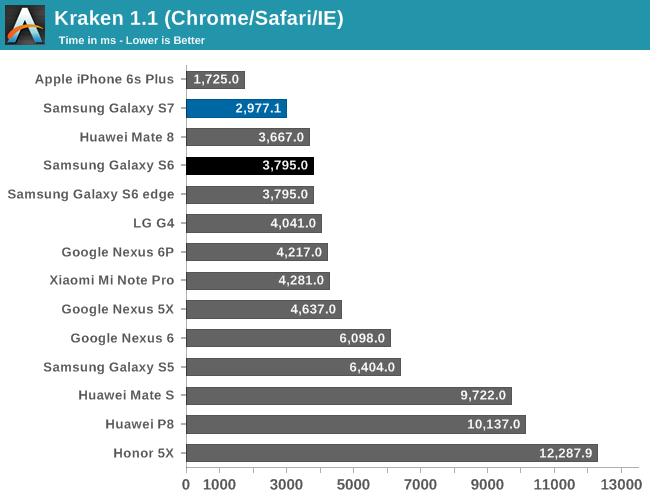

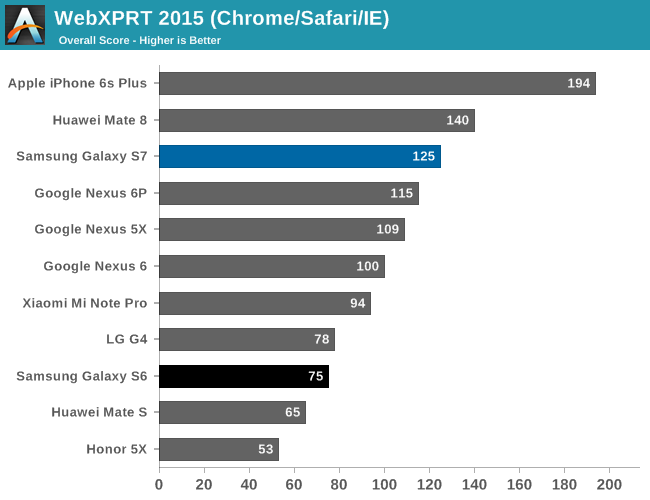
Starting off with our web benchmarks, we can see that in the time since our initial testing of the Snapdragon 820 MDP there have been some major improvements to how well Chrome is optimized for Kryo. As a result we're seeing results that are almost comparable to Snapdragon Browser in Chrome.
Overall then the Galaxy S7 and its Snapdragon 820 SoC won't top the charts on web benchmarks - Apple still holds an edge here - however the Galaxy S7 puts up a solid fight. The one drawback here is that the Mate 8 and its Cortex A72 CPU seems to have the edge over the Galaxy S7.
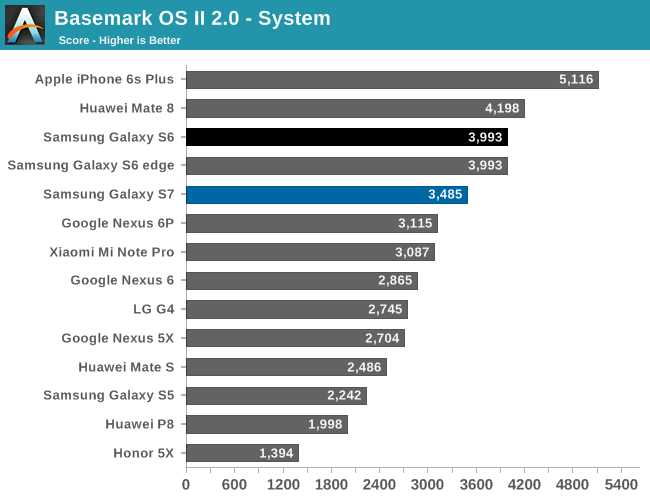
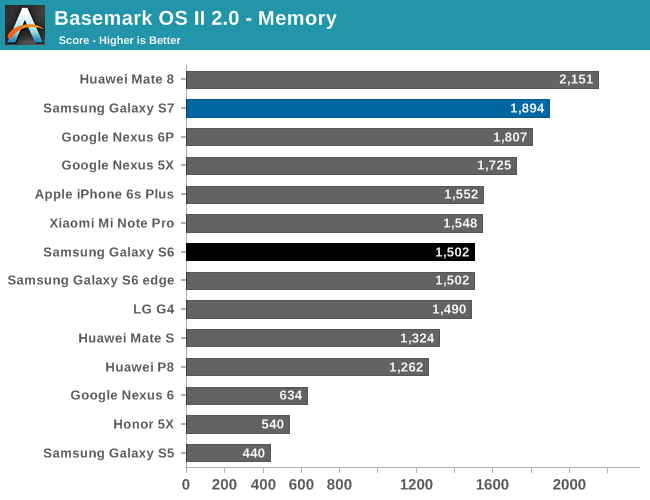
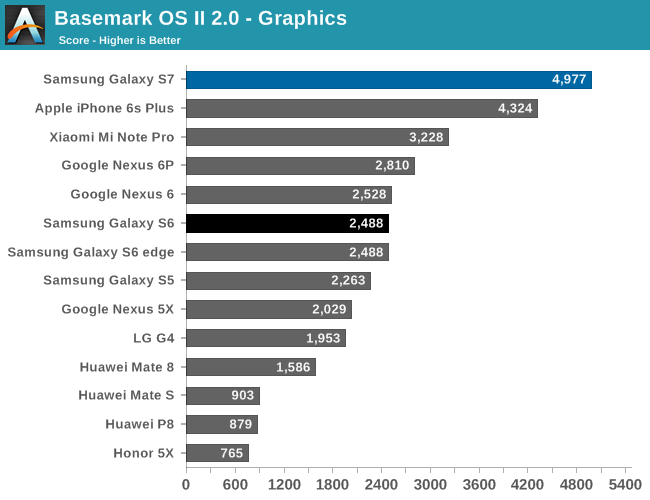
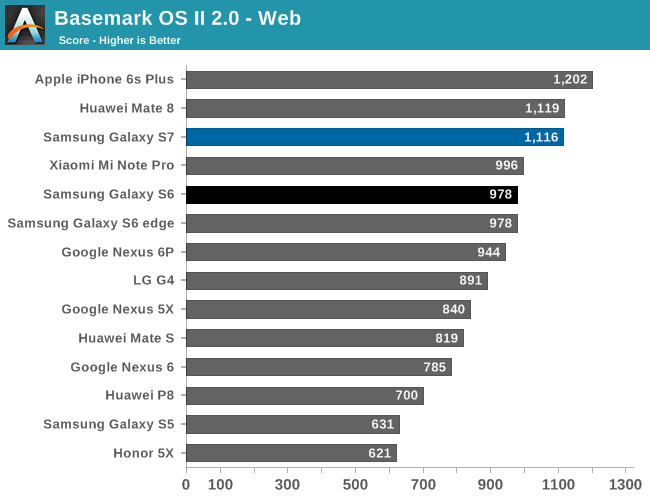
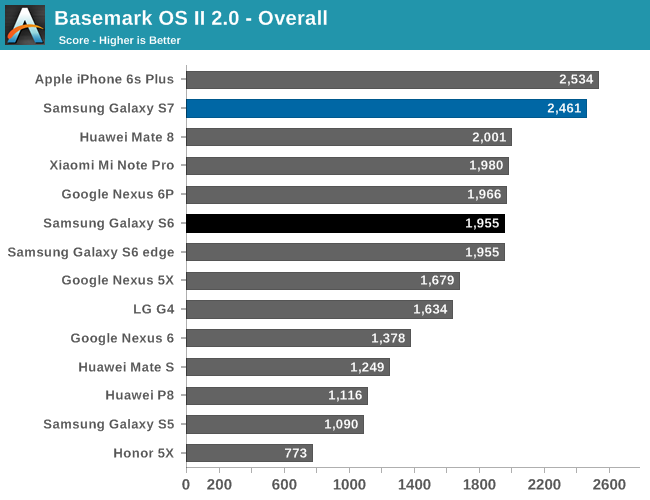
In Basemark OS II the combination of a better GPU, better NAND, and better single thread CPU performance seems to be enough for the Galaxy S7 to approach the iPhone 6s Plus in overall performance. While the system benchmark shows that Kryo isn't quite going toe to toe with Twister, the Adreno 530 helps to narrow the gap in the graphics test.
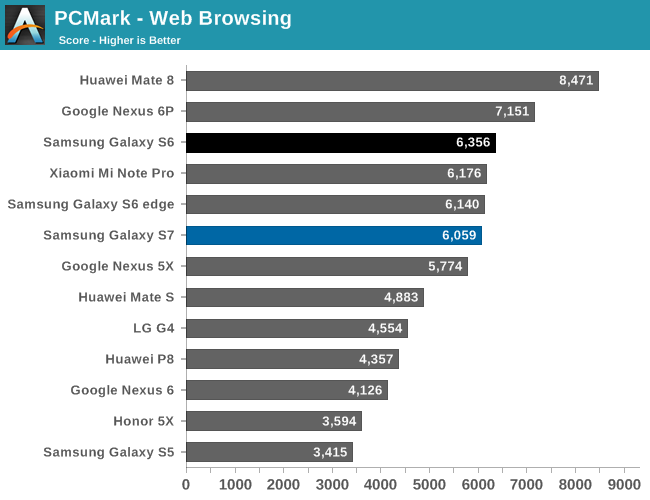
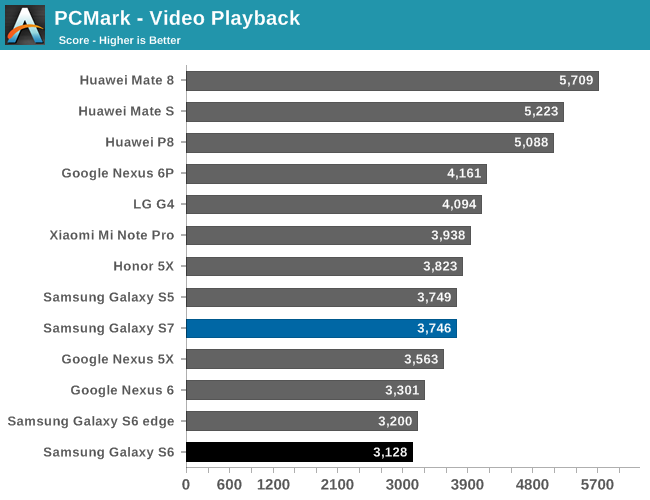


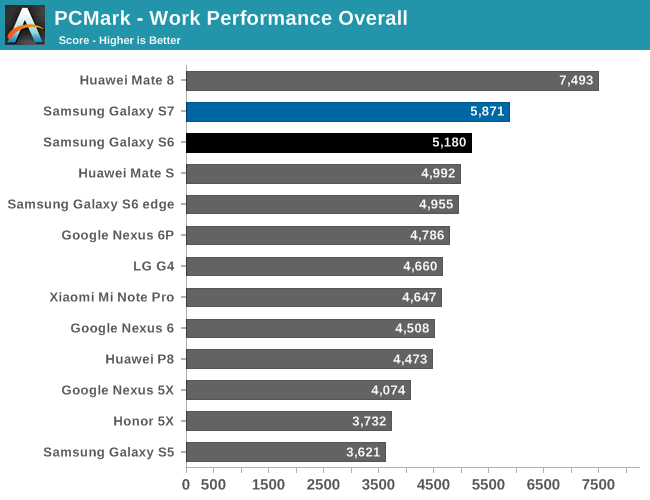
In PCMark, we can see that the Galaxy S7 is mostly comparable to the Galaxy S6. However major improvements in areas like GPU performance help to give it an overall advantage relative to the Galaxy S6 in the photo editing test. Given that this is basically a test of API-level performance, it's likely that Samsung's frameworks and governor settings lead to mostly similar performance in these tests.
Overall, the Snapdragon 820 appears to provide a pretty healthy bump in performance over almost every SoC seen in 2015, although it's hard to declare a clear winner when comparing it to Apple's A9 or Huawei's Kirin 950. If you glanced at the battery life graphs and the performance graphs above it's pretty obvious that Qualcomm has made some enormous strides here. While not quite going from zero to hero, Qualcomm has come close, and that definitely deserves some credit.
NAND Performance
If you think about the memory hierarchy, while RAM and cache are important, at the end of the day the most important aspect is the base storage. Even if you have infinite RAM and cache, if your storage is sufficiently slow the user experience is going to be painful for at least the first time you have to load something.
In order to test this, we use our standard test of AndroBench with 4 KB and 256 KB reads and writes for random and sequential tests. I went ahead and did some digging around to figure out exactly what it is we’re testing in the Galaxy S7, and it turns out that while the Galaxy S7 storage solution is similar to what’s in the Galaxy S6 and S6 edge, it isn’t quite the same. The Galaxy S7 UFS storage identifies itself as the KLUBG4G1CE-B0B1, which looks to be in the same family and appears to have been released at pretty much the same time as the Galaxy S6 storage solution, but the model number isn’t quite the same.
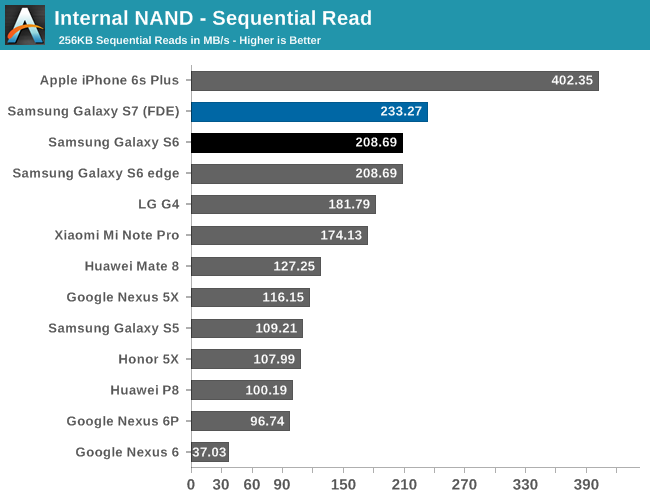
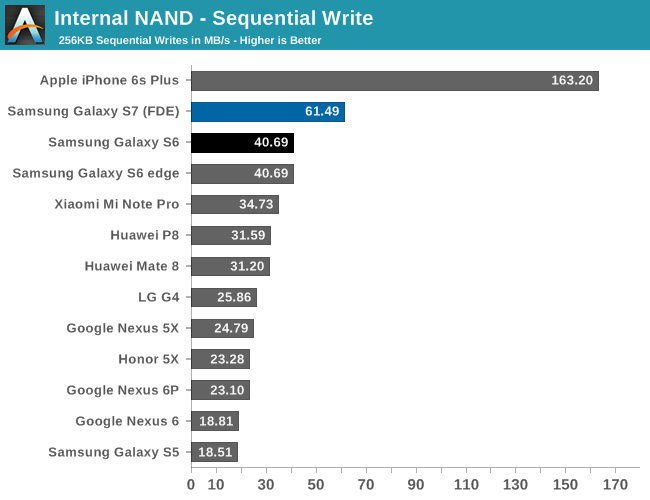
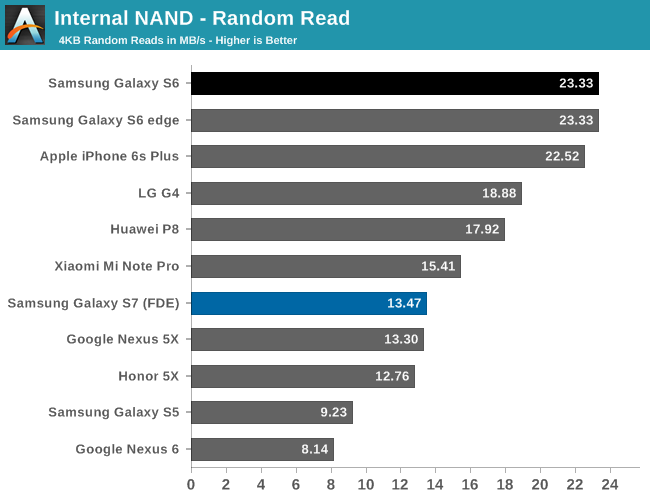
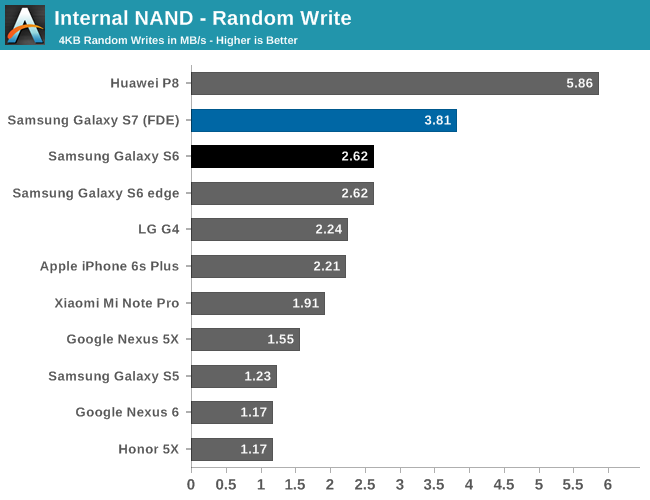
Looking at the performance results, we can also see that the Galaxy S7 is pretty similar to the Galaxy S6 in storage performance at a high level. Interestingly enough despite using full disk encryption on the Galaxy S7, we don’t really see a noticeable degradation in performance relative to the Galaxy S6 which is good to see considering the number of Android devices that do have noticeable performance effects when enabling FDE.










202 Comments
View All Comments
Arch_Fiend - Tuesday, March 8, 2016 - link
Very good review the S7 is a beast but so is my iPhone 6s plus. I wish I could afford to have 2 high-end smartphones because I would definitely by the S7 if I could because its finally the android phone i've been waiting for.Cant wait for review part 2.
misteroh - Tuesday, March 8, 2016 - link
I'm very glad you updated your battery testing methodology. I have the LG G4 and my personal experience with its battery life is MUCH closer to your 2016 test results than the 2013. The older test would have you believe it has much better than average battery life, but I personally find myself charging it much more often than I want to.stlc8tr - Tuesday, March 8, 2016 - link
I'm curious about the microSD card slot performance. If you put a fast (<80MB) microSD card in the GS7, are you going to see the difference over a slower card?Also, how fast is the USB MTP performance? Did Samsung re-introduce a USB3 connection?
tipoo - Tuesday, March 8, 2016 - link
It would depend on what you put on the card. Videos and music would probably see no difference. Apps, and if the camera can write directly to the card, maybe.H4CTOR96 - Friday, March 18, 2016 - link
I put a Sandisk 64gb Extreme on mine and A1 SD Bench returns 60Mb/s read and 40Mb/s write. For comparison the Internal storage works at 300 read and 150 write....Then I put in a crappy $7 32gb sd card and it scored 1032 write and 1.02 read, so yeah there was something wrong with that one XD
name99 - Tuesday, March 8, 2016 - link
"Of course, other than the workload the device setup has been held constant across these tests by equalizing ... disabling all background sync to the best of my ability."Is this really a good idea? Id argue that part of what you are buying when you buy these devices is proper setup. (Certainly, for example, that's part of what Apple would say they are selling.) As such, I'd consider that the right way to benchmark them is in some sort of "as close to out-the-box" state as possible. Sign up for everything the device asks you to sign up for out the box. (For Apple that will be to enter an AppleID, for Android I assume it will always ask for a Google ID and then some random collection of additional logins that people have paid the phone vendor to request.)
Then see how the phone behaves under those conditions. The Apple pone will presumably occasionally sync with iCloud. The Android phone will sync with various Google Services. And if the vendor asked you to sign up for "MyWannabe Social Network" and "MyWannabe Social Network" delivers ads to the device every three minutes, constantly sucking up power and CPU, THAT IS THE EXPERIENCE THE PHONE IS SELLING YOU.
Vendors that sell crap like that should accept the consequences in reviews. It's not AnandTech's job to spend an hour scrubbing some phone of useless crap. It is, in fact, AnandTech's job to run the phone with precisely all that crap enabled --- and then let us know the results.
Andrei Frumusanu - Tuesday, March 8, 2016 - link
By background syncing Josh is mostly referring to disabling application auto-updates and other such services which can have an impact on battery life tests. The usual small sync services and GMS have little to no noticeable impact on these tests.I disagree on your viewpoint about out-of-box software settings simply because the phones have different software and services depending on your region. North American units from carriers will have different settings and services than the international units. We don't always get samples from the same carrier even. AnandTech has been first and foremost a hardware site so I think it's correct to try to minimize the effect of such services to get a better representation of what the device itself is capable of, not what the carriers choose to add in or not.
Again, this is all overblown as in practice we see little to no effect on our tests and again we're mostly referring to auto-updates and the like which can eat up singificant amount of CPU cycles.
name99 - Tuesday, March 8, 2016 - link
" Always-On Display is nice to have, but for some reason it only polls the ambient light sensor, so the display won’t actually turn off in your pocket. As a result I turned it off as it’s clearly going to be contributing to idle battery drain in situations where it shouldn’t."Like I said...
I think it is not helpful to improving phones generally when reviewers accept stupidity like this.
If Samsung ship with a feature that's not ready for primetime, the review numbers (in this case battery life) should show it. I don't understand why so many phone users are willing to make excuses for manufacturers and just accept babysitting their machines, manually switching on and off GPS, Bluetooth, WiFi, NFC, etc as the situation demands.
My devices should damn well operate themselves, not rely on me to do it for them.
adityarjun - Tuesday, March 8, 2016 - link
If you do a quick google search, you'll see that a lot of users are still facing keyboard lag. Check reddit and xda.I would like to hear your thoughts on the same and whether you are also facing such issues.
jhh - Tuesday, March 8, 2016 - link
Still disappointed that Samsung didn't at least allow enabling using the SD card as extended internal memory. Yes, some people want to swap the cards in and out, but others have found they have run out of internal memory, and have no choice but to buy a new phone without this feature.